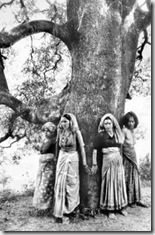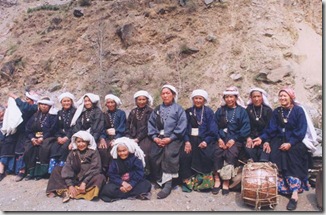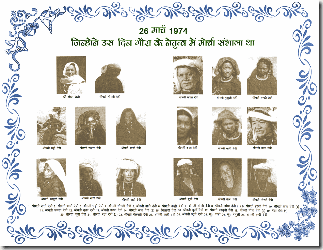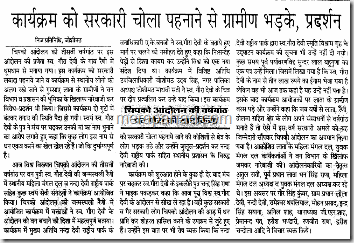In hindi the word Chipko means "to stick" or “to embrace” or “to hug” and that is what the Uttarakhandi women have done in 70’s to save the trees. Chipko Movement, started in 1970’s, was a non violent movement aimed at protection and conservation of trees and forests from being destroyed. The villagers used to hug the trees and protect them from wood cutters from cutting them. Chipko movement was based on the Gandhian philosophy of peaceful resistance to achieve the goals. It was the strong uprising against the against those people, who were destroying the natural resources of the forests and disturbing the whole ecological balance.
 The landmark event in this struggle took place on March 26, 1974, when a group of female peasants in Reni village, Hemwalghati, in Chamoli district, Uttarakhand, India, acted to prevent the cutting of trees and reclaim their traditional forest rights that were threatened by the contractor system of the state Forest Department, and transpired hundreds of such grassroots level actions, throughout the region. When the Forest Department announced an auction of 2500 trees in the Reni Forest overlooking the Alaknanda River, which had already flooded disastrously, one woman- Gaura Devi- organized the women of her village to protect the trees from the company that won the auction. They physically prevented the tree felling, and thus forced the Uttar Pradesh government to investigate. Two years later, the government placed a 10-year ban on all tree felling in the area. Later on the ban was imposed in Himachal Pardesh, Karnataka, Rajasthan, Bihar, Western Ghats and Vindhayas. All this was done on the order of the Indian Prime Minister after the strong protests by the activists through out the country. After that, women prevented felling in many other forests all along the Himalayas. They have also set up cooperatives to guard local forests, and to organize fodder production at rates that will not harm the trees. Within the Chipko movement, women have joined in land rotation schemes for fodder collection, helped replant degraded land, and established and run nurseries stocked with species they select. By the 80s, the movement spread throughout India, and led to formulation of people sensitive forest policies and stopping of open felling of trees in regions.
The landmark event in this struggle took place on March 26, 1974, when a group of female peasants in Reni village, Hemwalghati, in Chamoli district, Uttarakhand, India, acted to prevent the cutting of trees and reclaim their traditional forest rights that were threatened by the contractor system of the state Forest Department, and transpired hundreds of such grassroots level actions, throughout the region. When the Forest Department announced an auction of 2500 trees in the Reni Forest overlooking the Alaknanda River, which had already flooded disastrously, one woman- Gaura Devi- organized the women of her village to protect the trees from the company that won the auction. They physically prevented the tree felling, and thus forced the Uttar Pradesh government to investigate. Two years later, the government placed a 10-year ban on all tree felling in the area. Later on the ban was imposed in Himachal Pardesh, Karnataka, Rajasthan, Bihar, Western Ghats and Vindhayas. All this was done on the order of the Indian Prime Minister after the strong protests by the activists through out the country. After that, women prevented felling in many other forests all along the Himalayas. They have also set up cooperatives to guard local forests, and to organize fodder production at rates that will not harm the trees. Within the Chipko movement, women have joined in land rotation schemes for fodder collection, helped replant degraded land, and established and run nurseries stocked with species they select. By the 80s, the movement spread throughout India, and led to formulation of people sensitive forest policies and stopping of open felling of trees in regions.
Several Books were wriiten on Chipko Movement. One booklet, in which Gaura Devi’s story was detailed, "Emancipated Women-Folk of Uttarakhand", brought out by the Himalayan Action Research Centre, Dehradun. An abridged version was recounted by C.S. Lakshmi in her Hindu article, Lessons from the Mountains: The Story of Gaura Devi.
Everyone by now knows about the Chipko Movement. But not many know about the women of the Uttarakhand region who have made it their lifetime mission to leave undestroyed forests for their children and grandchildren. One has known old women and men who, towards the end of their lives, would plant trees which would bear fruits only many years later. When questioned these old people are known to have replied, "I won’t be here to taste the fruits of this tree. But my grandchildren and their children would taste its fruits." The women of Uttarakhand would understand this sentiment for this has been their way of looking at the forests and the lives they support.
One woman whom future generations in Uttarakhand are not likely to forget is Gaura Devi who has mobilised the women of this region to protect their natural heritage. Gaura Devi was not educated in the conventional sense of the term. She had not attended any school. Born in 1925 in a tribal Marchha family of Laata village in Neeti valley of Chamoli district, she was only trained in her family’s traditional wool trade. In keeping with the tradition of those days, she was married off at a young age. She went to a family which had some land and was also in the wool trade. Unfortunately at the young age of 22, Gaura Devi became a widow with a two-and-a-half year old child to bring up. She took over the family’s wool trade and brought up her son Chandra Singh alone. In time, she handed over the family responsibility to her son but did not sit back to rest. She was aware of the poverty of the region and how it affected women and how her own experiences of survival had taught her a lot. She was actively involved in the panchayat and other community endeavours. Hence, it was not surprising that the women of Reni approached her in the wake of the Chipko Movement in 1972, to be the president of the Mahila Mangal Dal. It was the first of its kind to be established. Its responsibilities were ensuring cleanliness in the village and the protection of community forests. Gaura Devi was in her late forties and her son was not doing very well. But she had no hesitation in accepting their offer.
The awareness generated by the Chipko Movement had already spread in all the areas of the region. Gaura Devi took up several campaigns to spread awareness in the nearby villages. Not only did the women but everyone in that region realised what the forests meant to them. Gaura Devi always referred to the forests as their gods. So the people of Reni were quick to react when the government authorised the felling of the trees in the belt and gave the job to contractors. They held demonstrations of protest. But little did they know that the date for the felling had already been fixed. It was fixed for March 25, 1974. That day, a group of forest officials along with some labourers started moving towards the forests. A young girl saw them and she went running back to report to Gaura Devi. That day there were no men in the village. All of them had gone to Chamoli. Undaunted, Gaura Devi and 27 women of Reni village began to march towards the forests. Soon they reached the group of men and their labourers who were cooking their food. Initially they tried to reason with them and told the labourers to leave after they ate their food. The officials who were already a bit drunk began to hurl obscenities at Gaura Devi and her group of women and told the labourers to go ahead and cut the trees. They were then told in no uncertain terms that if they attempted any such thing the women would cling to the trees. One of the officials who was drunk brandished a gun. The women stood in a row, each one of them looking as if the mountain goddess Nanda Devi had taken one of her fierce forms. They then chased the labourers for nearly two kilometres and broke the cement bridge leading to the forests. A group of them sat guarding the rest of the men and kept vigil throughout the night.
 The Chipko Movement gained momentum under Sunderlal Bahuguna, an eco activist, who spent his whole life persuading and educating the villagers, to protest against the destruction of the forests and the Himalayan mountains by the government. It was he, who made appeal to the Prime Minister of India Mrs Indira Gandhi to ban the cutting of tress. He shouted the slogan ‘ecology is the permanent economy’. Another main leader of the movement was Mr. Chandi Prasad Bhatt, who advocated the development of small scale local industries, which were based on the sustainable use of the forests resources for the local benefits. There were many slogans that originated during that period. For example :-
The Chipko Movement gained momentum under Sunderlal Bahuguna, an eco activist, who spent his whole life persuading and educating the villagers, to protest against the destruction of the forests and the Himalayan mountains by the government. It was he, who made appeal to the Prime Minister of India Mrs Indira Gandhi to ban the cutting of tress. He shouted the slogan ‘ecology is the permanent economy’. Another main leader of the movement was Mr. Chandi Prasad Bhatt, who advocated the development of small scale local industries, which were based on the sustainable use of the forests resources for the local benefits. There were many slogans that originated during that period. For example :-
Jagigyan hum, beejigyan hum; Ab ni chalali choron ki
Ghor apuna, baun apuna; Ab ni chalali auron ki
(We have risen, we are awake; No longer will thiefs rule our destiny
It is our home, our forests; No longer will the others decide for us)
Maatu hamru, paani hamru, hamra hi chhan yi baun bhi
Pitron na lagai baun, hamunahi ta bachon bhi
(Soil ours, water ours, ours are these forests too
Our forefathers raised these, it is we who must protect these too)
Maatu bikigi, paani bikigi, bikigya hamara baun bhi
Haath khaali, pet khaali, thikanu ni kakhi raun ki
(Soil has been sold, water sold, our forests too have been sold off
Hands bare, stomachs empty, we have no shelter to stay)
 — Dhan Singh Rana "Adivasi", village Lata (Chamoli Garhwal)
— Dhan Singh Rana "Adivasi", village Lata (Chamoli Garhwal)
“Embrace the trees and
Save then from being felled
The property of our hills,
Save them from being looted”
Another one says :-
“Let us protect and plant the trees
Go awaken the villages
And drive away the axeman”
In the year 2004,on completion of 30 years of Chipko Movemnet. The anniversary celebrations were covered by differnt papers (see pictures) where government authorities criticised for dominating the celebrations in Reni and not involving local people. Gaura Devi’s only son, Chander Singh Rana, and Dhan Singh Rana raised this issue.
* Some Photo Courtsy : Rajiv Rawat




chipako aajadi ke baad ka uttarakhand ka pahla aandolan tha, lekin is aandolan ki shuruaat karane vaale chandi prasad bhatt the aur gaura devi ke netratva mai gramin mahilao ne aandolan kiya tha,
kuch svayam boo CHIPKOO netaao ne is aandolan ko rajniti ka hathiyar banaya aur iski dasha aur disha badalne ki koshish ki aur ve isme safal bhi ho gaye, apana to padma shree aadi le aaye lekin jin logo ne sangharsh kiya ve khali hath rah gaye.
is article ko padhkar un aandolankariyo ki aatma bhi santusht hui hogi, badhai hai sahi baat se rubru karane ke liye.
it becamethe stonges andolane in uttarakhand
चिपको आन्दोलन
या आन्दोलन ही नहीं था यू कहना श्रेकर होगा हारे अलग राज्य की मांग की एक नींव भी थी ! रैणी की जंगलो की की आवाज जिसकी गूंज आज पूरे संसार में सुनाई दी ! इस के सूत्र पात्र थी गौरा देवी ,एंड चांदी प्रसाद जी ! उन्हें हमरा सतत प्रणाम !
ये तो पेडो पर चिपके , अपने जंगलो को बचाने ,अपनी प्राकर्तिक धरोहर को बचाने लेकिन ………………..
इस आन्दोलन से लोगो ने अपने अपने अनुसार फायेदे भी उठाये ! कुछ मह्त्वाकाँशी लोगो पेडो की बजह , नेशन पपेरो पर जा चिपके जिसमे उन्हिने अपने खूब भुनाया इस आन्दोलन के नाम पर ! बिदेसो की सैर करी और अपनी सरकार से की मान सामान भी झटके !
Us waqt logon ne apne samaaj ke bare me socha tabhi chipko aandolan ne roop liya.chipko aandolan hua to paharo me lekin iska asar pure desh me hua.ye kehna atishyukti nahi hogi ki agar ye aandolan na hota to hamara hara bhara pahar na to hara bhara rehta na pahar rehta.unke is aandolan me itni takat thi k vrakshon k katan me rook lag.agar aaj bhi logon k ander wahi bhavna ho to hamare paharon ki surat badli ja sakti hai.
Congratulations, your site is highly informative,please continue to work on all the information that can be imparted regarding our state.As I teach in a school(k.v.), the information regarding 'Chipko movement', and 'Gaura Devi' will prove to be highly beneficial to our children and hopefully inspire them to feel proud of their state and learn to work for its betterment.
[…] 1930 का तिलाड़ी आन्दोलन हो या 1974 का चिपको आन्दोलन, या 1984 का नशा नहीं रोजगार दो आन्दोलन या […]
[…] का दशम दीक्षान्त समारोह एक तरह से ‘चिपको आन्दोलन’ को समर्पित रहा। समारोह की मुख्य […]
sunderlal bahuguna ji chipko movement was the first people’s movement for protecting enviorment and was very succesful movement i m proud to say that im a citizen of country like india were this type of movement were held to save our enviornment
The chipko movement is the name of the movement comes from a word meaning ’embrace’: the villagers hug the trees, saving them by interposing their bodies between them and the contractors’ axes.
The 1970s, an organized resistance to the destruction of forests spread throughout India and came to be known as the chipko movement.
They did what they did because they all would stand around a tree and hold hands and sing and tell the tree cutters to not cut it down but they did but they never stopped it what ever happened and they would just hug the trees to stop it getting felled. but the tree cutters would still attempt to cut the tree down even if they were still hugging the tree. So they chopped the people up because they would stand up for what they believed in.
They were mainly in India they were in tribe sort of things in India.
The words they believed in
Embrace the trees and
Save them from being felled;
The property of our hills,
Save them from being looted.’
It mainly took place in the foot hills in the Himalayas (in the mountains. )
They were normal people they were not rich they were just normal women sometimes men. But they were inspired by a story which a girl did years and years ago.
I think it was stupid to risk their lives for trees and for hugging them..
Great Article…..It gives me the immense pleasure of my school days.I read this chapter in History subject when i was studying in CBSE board.Keep it up.
i read this chapter in science subject
this is a great article………..
i really thankful to you..for this much fantastic article on chipko movement….thanku so much…
chipko movement an inspiration that in late twentith century the people took the initiative to protect trees for welfare of the future generation ,but now we are relentlessly cutting down the trees …………… save trees !!!!!!!!!!!
lets learn from it ………………..
great article
cheese
wow its a great site as i am a student of high school its very useful for me to prepare for my scholar ships
“LADIES ROCK”
She always remains in my soul and mind as “DIVA“ because her deed give me fresh air and inspiration.
it helped me a lot……………………. thank u
it also helped me a lot
aap kamal ho ji!!!!!!!!!!!!!!!!!!koi sak
i am a student. when i read this article ,i now know many points on chipko movement…………… i am greatful to you.
Excellent job done by team.
chipko movement started in chamoli is one of the best beginning to save our envoirment and planet earth from destruction.
very nice
excellent coverage . Gives credit to the rightfully deserving people of the 'pahar'. Makes me feel proud to be a woman and an Indian as well!!!
very nice ………………….we should take step forward 2 start a new youth chipko movement not only in uttranchal but in whole india…………..:)
Chipko movement was led by sunder lal bahuguna.he also conducted a peace march of about 3000 km in the regiom of u.p.
CHIMPO MOVEMENT STARTED IN 1970 TO SAVE TREES AND THAT IS VERY GOOD
chipko movement is one of the best movement .Main thing is that it was started by a lady ,which makes everybody feel proud .
Please keep me informed of new article.
chip ko movement is the very good team job. i m very proud of this movement . that is a excellent job
they are such a real hero who saves the tree
[…] The Chipko movement, led by Indian women, is an interesting example of very concrete activism, drawing on a humanization of nature and ideas of female empowerment. The Chipko movement emerged during the 70s as a form of non-violent ecological activism. Its members gathered to literally hug trees in order to prevent them being cut for industrial use. One of the movement’s supporters is renowned Indian philosopher and eco-feminist Dr. Vandana Shiva. Dr. Shiva linked the concerns of women to those of nature, stating that both were victims of a male-dominated, patriarchal society. In that vision, nature is brought back to its feminine aspect, and through identification with “her”, an emotional movement comes to life, to defend quite worldly causes. […]
Had we been serious to the Chipko movement and not influenced by our greed, we could have avoided the naural disaster of Kedarnath in Uttarakhand 16 June 2013. As described in our epic, Lord Shiva has started showing his anger and remainded us to protect our environment.
Today 26th March is the 40th anniversary of the Chipko Movement.
गौरा देवी और सभी चिपको आंदोलन के कार्यकर्ताओं को मेरा सलाम.
[…] The Chipko movement, led by Indian women, is an interesting example of very concrete activism, drawing on a humanization of nature and ideas of female empowerment. The Chipko movement emerged during the 70s as a form of non-violent ecological activism. Its members gathered to literally hug trees in order to prevent them being cut for industrial use. One of the movement’s supporters is renowned Indian philosopher and eco-feminist Dr. Vandana Shiva. Dr. Shiva linked the concerns of women to those of nature, stating that both were victims of a male-dominated, patriarchal society. In that vision, nature is brought back to its feminine aspect, and through identification with “her”, an emotional movement comes to life, to defend quite worldly causes. […]
NATURE HEALS